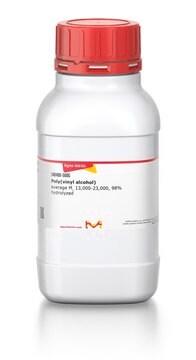1.04973
Potassium hexacyanoferrate(III)
for analysis EMSURE® ACS,Reag. Ph Eur
Synonyme(s) :
Potassium hexacyanoferrate(III), Potassium ferricyanide
About This Item
Produits recommandés
Qualité
ACS reagent
Niveau de qualité
Agence
reag. Ph. Eur.
Gamme de produits
EMSURE®
Essai
≥99.0% (iodometric)
Forme
solid
Impuretés
≤0.005% Insoluble matter
pH
6 (20 °C, 50 g/L in H2O)
Solubilité
464 g/L
Densité
1.85 g/cm3 at 20 °C
Masse volumique apparente
900‑1000 kg/m3
Traces d'anions
chloride (Cl-): ≤0.01%
hexacyanoferrate(II) ([Fe(CN)6]4-): ≤0.05%
sulfate (SO42-): ≤0.005%
Traces de cations
Pb: ≤0.002%
Température de stockage
2-30°C
Chaîne SMILES
[Fe-3](C#N)(C#N)(C#N)(C#N)(C#N)C#N.[K+].[K+].[K+]
InChI
1S/6CN.Fe.3K/c6*1-2;;;;/q;;;;;;-3;3*+1
Clé InChI
MIMJFNVDBPUTPB-UHFFFAOYSA-N
Vous recherchez des produits similaires ? Visite Guide de comparaison des produits
Application
- Silsesquioxane organofunctionalized with 4-amino-3-hydrazino-5-mercapto-1,2,4-triazole: Preparation and subsequent reaction with silver and potassium hexacyanoferrate(III) for detection of L-cysteine.: This study presents the preparation of a novel silsesquioxane composite functionalized with triazole, and its subsequent reaction with silver and potassium hexacyanoferrate(III). The resulting material is evaluated for its effectiveness in detecting L-cysteine, showcasing its potential in analytical chemistry applications (do Carmo et al., 2015).
- Concerted derivatization and concentration method with dispersive liquid-liquid microextraction for liquid chromatographic analysis of 5-hydroxyindoles in human serum.: This research discusses a novel approach for the analysis of 5-hydroxyindoles in human serum using liquid chromatography. The method involves derivatization and concentration via dispersive liquid-liquid microextraction, enhancing the detection capabilities in complex biological matrices (Hayama et al., 2013).
- Micro determination of cortisol and cortisone in umbilical cord blood by chemiluminescent high-performance liquid chromatography.: This paper focuses on the micro determination of cortisol and cortisone in umbilical cord blood using chemiluminescent HPLC. The study highlights the method′s sensitivity and precision for analyzing these important biomarkers (Hasegawa et al., 2010).
- Comparative study of different cross-linking agents for the immobilization of functionalized carbon nanotubes within a chitosan film supported on a graphite-epoxy composite electrode.: This study evaluates various cross-linking agents for immobilizing functionalized carbon nanotubes within a chitosan film on a composite electrode. The findings have significant implications for enhancing electrode performance in electrochemical sensors (Pauliukaite et al., 2009).
- Thin layer chromatography/fluorescence detection of 3,4-methylenedioxy-methamphetamine and related compounds.: This research explores the detection of MDMA and related compounds using thin-layer chromatography coupled with fluorescence detection. The method provides a reliable analytical technique for forensic applications (Kato et al., 2008).
Liaison
Remarque sur l'analyse
Insoluble matter: ≤ 0.005 %
Chloride (Cl): ≤ 0.01 %
Sulfate (SO₄): ≤ 0.005 %
Hexacyanoferrate (II) (Fe(CN)6)⁴⁻): ≤ 0.05 %
Pb (Lead): ≤ 0.002 %
Corresponds to ACS,Reag. Ph Eur
Informations légales
Mention d'avertissement
Warning
Mentions de danger
Conseils de prudence
Classification des risques
Aquatic Chronic 2 - Eye Irrit. 2
Risques supp
Code de la classe de stockage
13 - Non Combustible Solids
Classe de danger pour l'eau (WGK)
WGK 2
Point d'éclair (°F)
Not applicable
Point d'éclair (°C)
Not applicable
Certificats d'analyse (COA)
Recherchez un Certificats d'analyse (COA) en saisissant le numéro de lot du produit. Les numéros de lot figurent sur l'étiquette du produit après les mots "Lot" ou "Batch".
Déjà en possession de ce produit ?
Retrouvez la documentation relative aux produits que vous avez récemment achetés dans la Bibliothèque de documents.
Les clients ont également consulté
Notre équipe de scientifiques dispose d'une expérience dans tous les secteurs de la recherche, notamment en sciences de la vie, science des matériaux, synthèse chimique, chromatographie, analyse et dans de nombreux autres domaines..
Contacter notre Service technique










